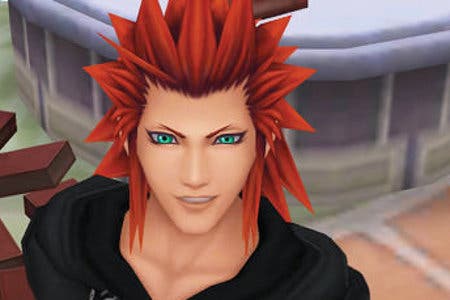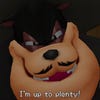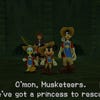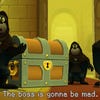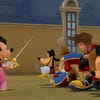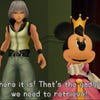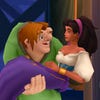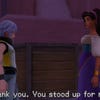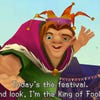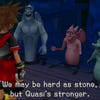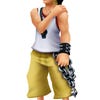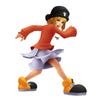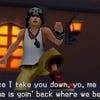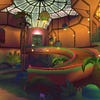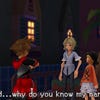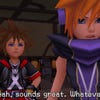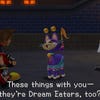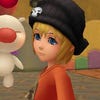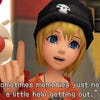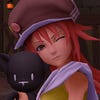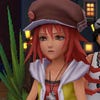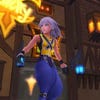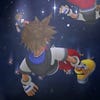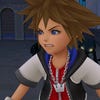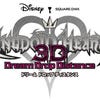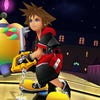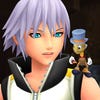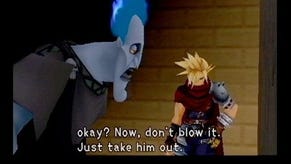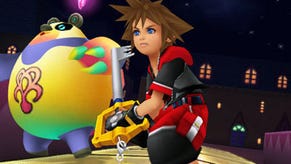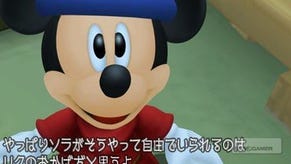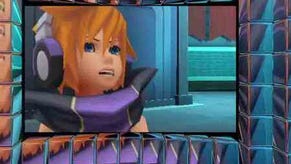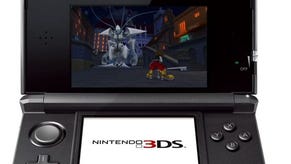Kingdom Hearts 3D: Dream Drop Distance
Demanding design delivers delight.
A meaningless jumble that makes more sense the longer you spend with it, the subtitle of this seventh entry in the sprawling Kingdom Hearts series is appropriate in more ways than one. This is an opaque, dense and often brilliant game, but one that doesn't give up its pleasures easily.
Put in a little thought and effort with both title and game, and everything starts to come together. The Dream part of the name refers to the basic concept of this entry, which picks up from the end of last year's Re:coded and leads into Kingdom Hearts 3. At the prompting of wizardly mentor Yen Sid, returning heroes Sora and Riku must complete the Mark of Mastery exam to become true Keyblade Masters. This involves visiting a series of all-new Disney-themed worlds that have been untouched in their previous adventures. This is because these worlds are asleep, and thus disconnected from the rest of the universe. Waking them up is your top priority.
Drop refers to how you travel between these worlds. Gone is the Gummi Ship transport, replaced with a tumble through dimensional portals, gathering stars and defeating enemies as you fall. Drop is also the mechanism by which you swap between Sora and Riku.
This brings us to Distance, as the friends have been shunted into parallel worlds and follow their own separate storylines throughout the game. You can 'drop' between them at save points, or else the decision will be made for you whenever a character's 'drop' meter runs dry. When that happens - even in the middle of a boss battle - it's time to pick up where you left off with the other character.
So while that name may seem like random words smashed together they do, eventually, do a pretty good job of explaining what the game is about. That's true of the game itself, which also looks bewildering and thrown together at first before coming into meaningful focus.
As with so many other Square franchises now deep into their lifespan, there's not much effort here to ease in any new players who don't come armed with six games worth of prior experience. The game opens with Sora and Riku on a desert island, which they escape from on a raft. Then they fight Ursula from The Little Mermaid. Then they're talking to a wizard about people and things you've never heard of. Then they're in a town. All the while, the game seems more interested in throwing a string of detailed gameplay tutorials at you, or belching out long elliptical conversations, rather than introducing you to the actual world of Kingdom Hearts.
Unless you've memorised the arcane plotlines of what came before, there's only the faintest sliver of a narrative thread to grab before the game whisks you off into its candy-coloured fantasia, and even then it helps to play with one finger over the pause button and a browser full of Wikipedia pages on different tabs.
Occasionally you'll get the prompt to watch a 'memento' - a cut-scene that fills in some details from a previous game - but these are piecemeal stuff, and often raise more questions than they answer. Simple matters such as who Sora and Riku are, and why we should care about them, are left largely untouched.
Narrative clarity is almost forced to take a backseat thanks to the deluge of new gameplay features that are introduced in the first hour or so of play. On the surface, things are much as you'd expect. You run around smallish maps, clobbering spawning enemies with your Keyblade on the way to the next area. Your abilities are accessed using the same Command Deck system as Kingdom Hearts Re:coded, putting special attacks, magic spells and items all in a stackable, scrollable menu in the corner of the screen.
Everywhere else, new features abound. As well as level-specific enemies drawn from the likes of The Hunchback of Notre Dame, Pinocchio, Fantasia, The Three Musketeers and even Tron Legacy, you'll be facing creatures called Dream Eaters. These rainbow coloured critters, looking for all the world like Viva Pinata and Pokemon had mutant babies, can also be your companions, provided you can find the correct recipe and the required dream pieces, dropped by defeated enemies.
Once created they'll follow you around and trigger Link Attacks when a gauge is full. You can also train them, level them up, unlock shared abilities, trade them and play AR games with them using the 3DS camera. Trigger a Link Portal and you can use your growing menagerie of Dream Eaters in StreetPass multiplayer bouts, though this feature is only vaguely explained in-game.
Flowmotion, meanwhile, allows you to hurl yourself around the environment. Activated by rolling into an object or larger enemy, it can be used to travel quickly or to unleash immensely powerful attacks. To begin with, it's basic stuff - high altitude slam attacks, whirling around a post and clobbering everyone in range, or throwing an enemy into the distance - but like almost everything else in Dream Drop Distance, the more you experiment, the more layers you uncover.
It's just a shame that the game's camera isn't always up to the task of keeping Flowmotion in the "pro" column as opposed to the "con". The whirling, lurching motion can be distracting or downright disorientating during combat, while the need to cram a lot of info into the small 3DS screen adds to the cramped feeling of data overload. The game is compatible with the Circle Pad Pro, it helpfully points out, and will no doubt look the business on the 3DS XL. It's just a shame that the greatest weakness in a game that pushes boundaries in so many other areas is something as old and irritating as a poor camera.
That's not the end of the features, though. There's also Reality Shift, in which certain objects and enemies open up even more movement and attack options. A pink reticule lets you know when you're close to something that can be Reality Shifted, and hitting X and A together then drags the action down onto the touchscreen.
You may be able to pull back and let fly with an Angry Birds style slingshot effect. In the Tron world of The Grid, you tap words to form code phrases that translate into different combat options. Faithline, on the other hand, is a join-the-dots exercise that sends you flying along the path you drew. It can be used to ping-pong between enemies or to cover long distances quickly, as in the Hunchback sections where you're chased by a gigantic boss Dream Eater and must stay out of its range.
These are the main additions, but they still barely scratch the surface of Dream Drop Distance's gameplay. This is the starting point, from which the game quickly dashes off to add more options, more stats to pick over, more resources to manage. So much of it is served up in the opening hour of the game, and so much depends on navigating dense menus stuffed with tiny options, that it can be more than a little overwhelming.
The opacity begins to make sense once you realise which model the game is following. Previous games in the series mashed-up the Disney worlds with characters and concepts from Final Fantasy, but Square's flagship franchise is almost entirely absent this time around, with only a few shopkeeper Moogles as remnants of the series' origin. Even Mickey Mouse takes his time before putting in an appearance, ceding the spotlight to Pinocchio, Quasimodo and Tron for the first half of the game.
Instead, this time the plot revolves around - and borrows from - the obscure 2008 cult RPG The World Ends With You. This tale of disaffected youth forced to fight for their lives against a vibrant, iconic backdrop of Tokyo's Shibuya district is a delightfully odd choice and one that chafes against the wide-eyed gee whizz pluck of the Disney license in all sorts of weirdly invigorating ways.
With that perspective in place, many of Dream Drop Distance's quirks slot into place. It shares the same feature overload as The World Ends With You, and serves them up with the same fidgety energy. There's nothing here quite as polarising as that game's dual screen battles, where the player had to juggle stylus touch screen work with buttons and directional inputs, but the overall tempo is the same.
Wherever you look, the game's overlapping features offer something to do, whether its the ever-expanding list of combat moves to be stacked and swapped in the Command Deck, or the ongoing meta-game of Dream Eater evolution that allows the action to spill out into the real world.
Worm your way past the stark information overload of the tutorials, and the game unfurls like a beaming cartoon flower. Each idea leads to a dozen more, each nestled inside another and overlapping with other ideas. Progression through the story is swift enough, but the character levelling puts a natural brake on the proceedings as you ferret out every last way of enhancing your spiralling ability list.
It's an astonishing web of gameplay mechanisms; sometimes a little graceless in its execution and not always masking the fact that much of your time is spent mashing the A button and walking in a straight line, but all the more rewarding once you figure out how to meet the game half way.
In many ways, despite the lavish Disneyfied worlds, this doesn't even feel like a Kingdom Hearts game a lot of the time. The change in tone and tempo may well come as a jolt to long time fans, just as the lumpen opening sections may deter newcomers, but it's rare to see a decade-old franchise reinvent itself with this much vigour. Kingdom Hearts 3D: Dream Drop Distance won't be for everybody, but those who fall under its spell are guaranteed a remarkable experience. Roll on Kingdom Hearts 3.
